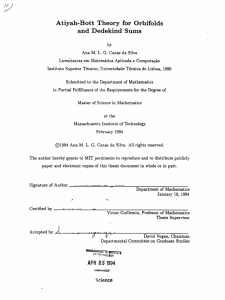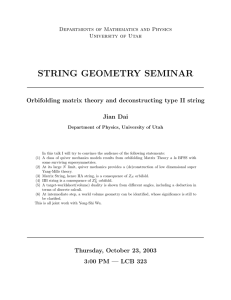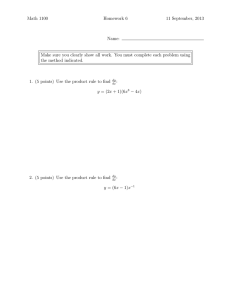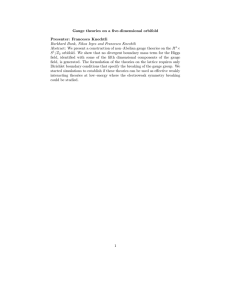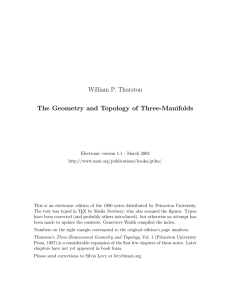Introduction to Orbifolds 1 Introduction April 25, 2011
advertisement
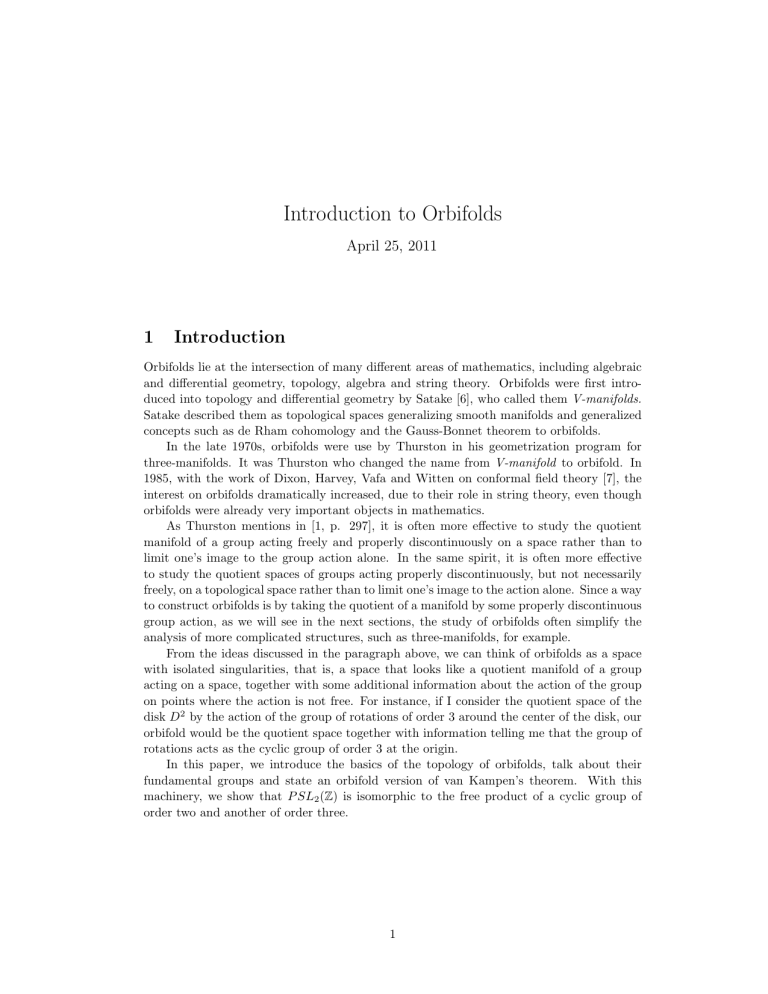
Introduction to Orbifolds
April 25, 2011
1
Introduction
Orbifolds lie at the intersection of many different areas of mathematics, including algebraic
and differential geometry, topology, algebra and string theory. Orbifolds were first introduced into topology and differential geometry by Satake [6], who called them V-manifolds.
Satake described them as topological spaces generalizing smooth manifolds and generalized
concepts such as de Rham cohomology and the Gauss-Bonnet theorem to orbifolds.
In the late 1970s, orbifolds were use by Thurston in his geometrization program for
three-manifolds. It was Thurston who changed the name from V-manifold to orbifold. In
1985, with the work of Dixon, Harvey, Vafa and Witten on conformal field theory [7], the
interest on orbifolds dramatically increased, due to their role in string theory, even though
orbifolds were already very important objects in mathematics.
As Thurston mentions in [1, p. 297], it is often more effective to study the quotient
manifold of a group acting freely and properly discontinuously on a space rather than to
limit one’s image to the group action alone. In the same spirit, it is often more effective
to study the quotient spaces of groups acting properly discontinuously, but not necessarily
freely, on a topological space rather than to limit one’s image to the action alone. Since a way
to construct orbifolds is by taking the quotient of a manifold by some properly discontinuous
group action, as we will see in the next sections, the study of orbifolds often simplify the
analysis of more complicated structures, such as three-manifolds, for example.
From the ideas discussed in the paragraph above, we can think of orbifolds as a space
with isolated singularities, that is, a space that looks like a quotient manifold of a group
acting on a space, together with some additional information about the action of the group
on points where the action is not free. For instance, if I consider the quotient space of the
disk D2 by the action of the group of rotations of order 3 around the center of the disk, our
orbifold would be the quotient space together with information telling me that the group of
rotations acts as the cyclic group of order 3 at the origin.
In this paper, we introduce the basics of the topology of orbifolds, talk about their
fundamental groups and state an orbifold version of van Kampen’s theorem. With this
machinery, we show that P SL2 (Z) is isomorphic to the free product of a cyclic group of
order two and another of order three.
1
04/10/2011
2
18.904 Final Project
Transformation Groups
Throughout this paper, all topological groups are assumed to be Hausdorff.
Definition 2.1. An action of a topological group G on a space X is a continuous map
G × X → X, denoted by (g, x) 7→ gx, so that g(hx) = (gh)x and that 1x = x.
Given x ∈ X, we define the group Gx = {g ∈ G | gx = x} as the isotropy subgroup of
x. The isotropy subgroup Gx of any point x is a closed subgroup of G. The action is said
to be free if Gx = {1}, for all x ∈ X. The set G(x) = {gx ∈ X | g ∈ G} is the orbit of x.
The action is said to be transitive if G(x) = X.
Given x ∈ X, the natural map λ : G/Gx → G(x) defined by gGX 7→ gx is a continuous
bijection. The orbit space X/G is the set of orbits in X endowed with the quotient topology
(with respect to the natural map X → X/G, which we will call the orbit map).
Let X be Hausdorff, on which G acts continuously and transitively. If we fix a point
x ∈ X, then for any U ⊂ X, we have that λ−1 (U ) = π({g ∈ G | gx ∈ U }), where π : G →
G/Gx is the projection map. This equality implies that λ−1 (U ) is open if U is open, which
implies that λ is continuous. But λ is not necessarily a homeomorphism. However, if G
and X are locally compact and if G has a countable basis of open sets then this map λ is a
homeomorphism, see [3, p. 2]. Therefore, we can state the following theorem:
Theorem 2.2. The map λ : G/Gx → X is a homeomorphism if both G and X are locally
compact and if G has a countable basis of open sets.
If Γ is a discrete group and X is a Hausdorff space such that Γ acts on X, this action is
said to be properly discontinuous, if given two points x, y ∈ X, there are open neighborhoods
6 ∅ for only finitely many γ ∈ Γ.
U of x and V of y for which (γU ) ∩ V =
3
Orbifolds
3.1
Definition of Orbifolds
Definition 3.1. An n-dimensional orbifold chart on a topological space X is a 3-tuple
˜ , G, π), where
(U
• Ũ is open in Rn ,
˜,
• G is a finite group of homeomorphisms of U
˜ → X is a map defined by π = π ◦ p, where p : U
˜ →U
˜ /G is the orbit map and
• π:U
˜
˜ /G onto an open subset
π : U /G → X is a map that induces a homeomorphism of U
U ⊂ X.
˜1 , G1 , π1 ) → (U
˜2 , G2 , π2 ) between two charts is a smooth embedding
An embedding λ : (U
˜1 → U
˜2 such that π2 ◦ λ = π1 .
λ:U
˜i , Gi , πi ) be two orbifold charts on X such that Ui = πi (U
˜i ), and
For i = 1, 2, let (U
x is a point in U1 ∩ U2 . We say that these charts are compatible if there exists an open
neighborhood V ⊂ U1 ∩ U2 of x and a chart (V˜ , H, φ) with φ(V˜ ) = V such that there are
˜i , Gi , πi ).
two embeddings λi : (V˜ , H, φ) → (U
2
04/10/2011
18.904 Final Project
˜α , Gα , πα )}α∈I
Definition 3.2. An n-dimensional orbifold atlas on X is a collection U = {(U
of compatible n-dimensional orbifold charts which cover X.
Definition 3.3. An orbifold O of dimension n consists of a paracompact Hausdorff space
XO together with an n-dimensional orbifold atlas of charts UO .
Example 3.4. A manifold is an orbifold where each Gα is the trivial group, so that we get
Ũα homeomorphic to Uα .
Definition 3.5. Let O1 = (XO1 , UO1 ) and O2 = (XO2 , UO2 ) be two orbifolds. A map
f : XO1 → XO2 is a smooth map between orbifolds if for any point x ∈ X there are charts
˜1 , G1 , π1 ) around x and (U
˜2 , G2 , π2 ) around f (x) such that f maps π1 (U
˜1 ) into π2 (U
˜2 )
(U
˜
˜
˜
˜
and can be lifted to a smooth map f : U1 → U2 such that π2 f = f π1 .
To be able to state van Kampen’s theorem in the orbifold version, we also need to define
a suborbifold. Therefore, we make the following definition:
Definition 3.6. A suborbifold O1 of an orbifold O is a subspace XO1 ⊂ XO together with
an embedding ι : XO1 ,→ XO .
3.2
Quotient Orbifolds
Proposition 3.7. If M is a manifold and G is a group acting properly discontinuously on
M, then M/G has the structure of an orbifold.
Proof. For any point x ∈ M/G, choose x̃ ∈ M projecting to x. Let Ix be the isotropy group
˜x of x̃
of x̃ (Ix depends of course on the particular choice of x̃). There is a neighborhood U
invariant by Ix and disjoint from its translates by elements of G not in Ix . The projection
˜x /Ix is a homeomorphism. To obtain a suitable cover of M/G, augment some
of Ux = U
cover {Ux } by adjoining finite intersections. Whenever Ux1 ∩ . . . ∩ Uxk 6= ∅, this means that
˜x ∩ . . . ∩ gk U
˜x has a corresponding non-empty intersection. This
some set of translates g1 U
1
k
intersection may be taken to be
^
}|
{
z
Ux1 ∩ . . . ∩ Uxk
with associated group g1 Ix1 g1−1 ∩ . . . ∩ gk Ixk gk−1 acting on it.
Observation. From now on, we are going to use the notation [M/G] to mean M/G as an
orbifold.
Note that each point x in an orbifold O has an associated group Gx , which is well defined
˜ /G, Gx is the isotropy group of any
up to conjugation: in a local coordinate system, U = U
˜
point in U corresponding to x.
The set
ΣO = {x ∈ X | Gx =
6 {1}}
is the singular locus of O.
Example 3.8. Consider the action of Z2 on R3 by reflection in the y −z plane. The quotient
space R3 /Z2 is the half-space x ≥ 0, which we will denote by F. Physically, one may imagine
a mirror placed on the y − z wall of F, as shown below. This quotient space has an orbifold
structure where each point z on the boundary of F has a neighborhood homeomorphic to
3
04/10/2011
18.904 Final Project
the quotient of a neighborhood U ⊂ R3 of z modulo Z2 . If z is a point of F not on the
boundary, then there exists a neighborhood U ⊂ R3 on which Z2 acts freely. Therefore, this
neighborhood is canonically homeomorphic to itself.
Example 3.9. One example which shows how orbifolds appear in algebraic geometry is
given by the Kummer surface, which is defined by the action of Z2 on T4 defined by
σ(eit1 , eit2 , eit3 , eit4 ) = (eit1 , eit2 , eit3 , eit4 )
where σ corresponds to the matrix I. The orbifold [T4 /Z2 ] has sixteen isolated singular
points. You can see it in the picture below.
4
04/10/2011
3.3
18.904 Final Project
Fundamental Groups of Orbifolds
When M in Proposition 3.7 is simply connected, then M plays the role of universal covering
space and G plays the role of the fundamental group of [M/G]. To formalize this, we will
now define the notion of a covering orbifold.
˜ with a projection
Definition 3.10. A covering orbifold of an orbifold O is an orbifold O
p : XO˜ → XO between the underlying spaces, such that the following conditions hold:
˜ ) (where (U
˜ , G, π) is a chart of O),
• each point x ∈ XO has a neighborhood U = π(U
−1
˜ /Gi , where Gi is some
for which each component Vi of p (U ) is homeomorphic to U
subgroup of G,
˜ /Gi → Vi is the homeomorphism above, πi : U
˜ →U
˜ /Gi is the quotient map
• if ψ i : U
and ψi = ψ i ◦ πi , we must have π = p ◦ ψi .
Observation. The underlying space XO˜ is not generally a covering space of XO .
˜ with a projection
Proposition 3.11 ([1] p. 305). Any orbifold O has a universal cover O
˜
p : O → O. In other words, if x ∈ XO − ΣO is a base point for O, then
p
Õ → O
is a connected covering orbifold with base point x̃ which projects to x, such that for any
other covering orbifold
p0
O0 → O
˜ → O0 of p to a covering map
with base point x0 , such that p0 (x0 ) = x, there is a lifting q : O
0
of O .
˜ of an orbifold O is automatically a normal cover ([5, p. 70, 71]):
The universal cover O
for any preimage of x̃ of the base point x there is a deck transformation taking x̃ to x.
Definition 3.12. The fundamental group of an orbifold O is the group of deck transforma˜
tions of the universal cover O.
This definition justifies the remark in the beginning of this section.
Example 3.13. Consider the action of Z3 on the complex plane C by rotations of order 3
around the origin. The quotient space is given by
C/Z3 ≈ {z ∈ C | z = |z|eiθ , 0 ≤ θ < 2π/3}.
Since the complex plane is a simply connected manifold and Z3 acts properly discontinuously
on C, we have that C/Z3 has the structure of an orbifold and C, together with the quotient
map, is a universal cover. By Proposition 1.40 in [5, p. 72], Z3 is the group of deck
transformations of this covering space and therefore we have that π1orb ([C/Z3 ]) = Z3 .
The fundamental groups of orbifolds can be computed in much the same ways as the fundamental groups of manifolds [1, p. 307]. In particular, we have a version of van Kampen’s
theorem for orbifolds, as stated below:
5
04/10/2011
18.904 Final Project
Theorem 3.14 (van Kampen for orbifolds). If O, O1 and O2 are orbifolds such that O =
O1 ∪ O2 , where O1 ∩ O2 is path connected, then:
π1orb (O) ≈ π1orb (O1 ) ∗π1orb (O1 ∩O2 ) π1orb (O2 ).
Corollary 3.15. If O, O1 and O2 are orbifolds such that O = O1 ∪ O2 , where O1 ∩ O2 is
path connected, and if O2 is a simply connected manifold, then π1orb (O) ≈ π1orb (O1 ).
In particular, the corollary above states that if we have an orbifold O whose underlying
space is simply connected and which has only one singular point x, then the fundamental
group of O is the isotropy group of x.
4
Projective Special Linear Group
The projective special linear group PSL(2, Z) is the quotient of SL(2, Z) by its center {I, −I},
with group operation being multiplication of matrices. The projective special linear group
is isomorphic to the modular group Γ, that is, the group of linear fractional transformations
of the upper half of the complex plane (we will call the upper half plane H from now on)
which have the form
az + b
z 7→
cz + d
where a, b, c, and d are integers such that ad − bc = 1. The group operation is function
composition.
az + b
Let us now consider the action of SL(2, R) on H defined by σz =
cz + d
a b
where σ =
is an element of SL(2, R) and z ∈ H. This action is transitive, since for
c d
!
1
1
a 2 ba 2
a > 0,
sends i to ai + b.
1
0 a− 2
Let Gi be the isotropy group of i ∈ H. It is easy to see that Gi = SO(2). Therefore,
by Theorem 2.2, H is homeomorphic to SL(2, R)/Gi = SL(2, R)/SO(2) through the map
λ : SL(2, R)/SO(2) → H defined by λ(γ) = γi.
Since H is homeomorphic to SL(2, R)/SO(2), and since PSL(2, Z) is a discrete subgroup
of SL(2, R), we have that PSL(2, Z) acts properly discontinuously on H, due to Proposition
1.6 in [3, p. 3].
Now that we know that PSL(2, Z) acts properly discontinuously on H, we will find the
fundamental domain for H/PSL(2, Z).
Definition 4.1. For any discrete subgroup G of SL(2, R), we call F a fundamental domain
for H/G if F satisfies the following conditions:
(i) F is a connected subset of H
(ii) no two points of F are equivalent under G
(iii) every point of H is equivalent to some point of the closure of F under G
6
04/10/2011
18.904 Final Project
Proposition 4.2. A fundamental domain F for H/PSL(2, Z) is given by:
F = {w ∈ C | −
a
Proof. Let z ∈ H and σ =
c
Im(σz) = Im(
1
1
< Re(w) < , |w| > 1}.
2
2
b
∈ P SL(2, Z). Then
d
az + b
az + b cz + d
(ad − bc)Im(z)
Im(z)
·
=
.
) = Im(
)=
cz + d
cz + d cz + d
|cz + d|2
|cz + d|2
Since {cz+d | (c, d) ∈ Z2 } is a lattice in C, we have that min(|cz+d|) exists, for (c, d) 6= (0, 0).
Thus, for a given z, this implies that
max {Im(σz)} exists.
σ∈P SL(2,Z)
0 1
Let γ =
. If we have σ such that Im(σz) is maximum, and if we set w = σz =
−1 0
x + iy, where x, y ∈ R, then
Im(γσ(z)) = Im(−1/w) =
y
≤ y ⇒ |w | ≥ 1
|w|2
1 1
, then Im(τ k σ(z)) = Im(σ(z)) for every k ∈ Z, which implies that
0 1
|τ k σ(z)| ≥ 1. By a suitable choice of k, z is equivalent to a point of the region
Thus, if τ =
{w ∈ C | −
1
1
≤ Re(w) ≤ , |w| ≥ 1}.
2
2
This region is the gray region shown below with its boundary. Denote by F the interior
of the set above.
Now, to show that this F is a fundamental domain for PSL(2, Z), we only need to show
that no two points in F are equivalent under the action of PSL(2, Z). We will prove this by
contradiction.
7
04/10/2011
18.904 Final Project
a b
in PSL(2, Z)
c d
such that z 0 = σz. We can assume that Im(z) ≤ Im(z 0 ) = Im(z)/|cz + d|2 . Then, we have
that
Let z and z 0 be distinct points of F. Suppose that there exists a σ =
|c| · Im(z) = |c · Im(z) + 0| ≤ |c · Im(z) + c · Re(z) + d| ≤ |cz + d| ≤ 1
(∗)
If c = 0, then a = d = ±1, hence z 0 = z ± b, which
is impossible. Therefore, we must
√
3
have c 6= 0. Because z ∈ F, we must have Im(z) > 2 , which together with (∗), implies
√
3
2
|c| ·
≤ |c| · Im(z) ≤ 1 ⇒ |c| ≤ √ ⇒ |c| = 1
2
3
Then, from (∗), we obtain |z + d| ≤ 1. But if z ∈ F and |d| ≥ 1, we have |z + d| > 1.
Therefore, we must have d = 0. But this implies that |z| ≤ 1, which contradicts the fact
that z ∈ F.
Since the transformation z 7→ z −1 takes any element z ∈ {w ∈ H | Re(w) = 12 , |w| ≥ 1}
to an element z 0 ∈ {w ∈ H | Re(w) = − 21 , |w| ≥ 1} and since the transformation z 7→ − z1
takes any element u ∈ {w ∈ H | 0 ≤ Re(w) ≤ 12 , |w| = 1} to an element u0 ∈ {w ∈ H | − 12 ≤
Re(w) ≤ 0, |w| = 1} we have that the set
F 0 = F ∪ {w ∈ H | −
1
1
≤ Re(w) ≤ 0, |w| = 1} ∪ {w ∈ H | Re(w) = − , |w| ≥ 1}
2
2
is a set of representatives for H modulo PSL(2, Z).
5
Application: Proof That PSL(2, Z) ≈ C2 ∗ C3
Theorem 5.1. The map
which takes 1Z/2 7→
0
−1
h : Z/2 ∗ Z/3 → PSL(2, Z)
1
−1 − 1
and 1Z/3 7→
is an isomorphism.
0
1
0
Proof. In Section 4, we saw that PSL(2, Z) acts properly discontinuously on H. Hence, by
Proposition 3.7, we have that H/PSL(2, Z) has the structure of an orbifold. Because H is
simply connected, PSL(2, Z) is the fundamental group of the orbifold [H/PSL(2, Z)], as we
remarked in the beginning of Section 3.3.
Hence, to prove our claim, we only need to find the fundamental group of the orbifold
[H/PSL(2, Z)].
From the previous section, we have that the underlying space of [H/PSL(2, Z)] can be
represented by the set F 0 , inheriting the quotient topology. Since the set of singular points
of F 0 is ΣF 0 = {i, e2πi/3 }, [3, p. 14, 15] if we take the suborbifolds of F 0 defined by the
subspaces
1
1
F1 = {z ∈ F 0 | Re(z) < − } ∪ {z ∈ F 0 | Re(z) > }
4
4
and
1
1
F2 = {z ∈ F 0 | − < Re(z) < },
3
3
8
04/10/2011
18.904 Final Project
inheriting the subspace topology, by applying the van Kampen theorem version for orbifolds
on F 0 , F1 and F2 , we obtain that
π1orb (F 0 ) = π1orb (F1 ) ∗π1orb (F1 ∩F2 ) π1orb (F2 ).
(∗∗)
The underlying space of F1 ∩ F2 is defined by the subspace
{z ∈ F 0 | −
1
1
1
1
< Re(z) < − } ∪ {z ∈ F 0 | < Re(z) < }
3
4
4
3
inheriting
the subspace topology. If z = a + ib is an element of H such that |z| = 1 and
0 1
γ=
, then γz = −1/z = −z = −a + ib. Hence, we obtain that {z ∈ F 0 | − 13 <
−1 0
Re(z) < − 14 , |z| = 1} is (canonically) equivalent to {z ∈ F 0 | 14 < Re(z) < 13 , |z | = 1} via
the map z 7→ −1/z. Therefore, we have that F1 ∩ F2 is a connected orbifold. Since every
point in F1 ∩ F2 has a trivial isotropic group, we have that F1 ∩ F2 is a manifold. Because
F1 ∩ F2 is contractible, we get that π1orb (F1 ∩ F2 ) is the trivial group. Hence, (∗∗) becomes
π1orb (F 0 ) = π1orb (F1 ) ∗ π1orb (F2 ).
(∗ ∗ ∗)
The orbifold F1 has only one element whose isotropy group is nontrivial,
namely
w=
−
1
−
1
e2πi/3 . Its isotropy group Γw is the cyclic group generated by σ =
. Because
1
0
σ 3 = I, we have that Γw = C3 . Since XF1 is contractible and since F1 has only one singular
point, by Corollary 3.13 we have that π1orb (F1 ) ≈ C3 .
The isotropy group of i ∈ F2 is a cyclic group of order 2. Since i is the only singular
point of F2 , by a similar argument we have that π1orb (F2 ) ≈ C2 .
Therefore, (∗ ∗ ∗) gives us the desired result.
9
04/10/2011
18.904 Final Project
References
[1] William Thurston. The Geometry and Topology of Three-Manifolds
sey: Princeton University Press, 1997
New Jer-
[2] Lizhen Ji, Shing-Tung Yau. Transformation Groups and Moduli Spaces of Curves
Boston: International Press of Boston, 2010
[3] Goro Shimura. Introduction to the Arithmetic Theory of Automorphic
Functions New Jersey: Princeton University Press, 1971
[4] Alejandro Adem, Johann Leida & Yongbin Ruan Orbifolds and Stringy Topology
New York: Cambridge University Press, 2007
[5] Alan Hatcher Algebraic Topology New York: Cambridge University Press, 2002
[6] I. Satake On a generalization of the notion of manifold
USA 42 (1956), 359-363
Proc. Nat. Acad. Sci.
[7] L.J. Dixon, J.A. Harvey, C Vafa & E. Witten Strings on orbifolds I
B 261:4 (1985), 678-686
Nuclear Phys.
[8] Joan Porti An Introduction to Orbifolds Lorentz Center, 2009
[9] Paul A. Schweitzer et. al. Differential Topology, Foliations, and Group Actions
Rhode Island: American Mathematical Society, 1992
10
MIT OpenCourseWare
http://ocw.mit.edu
18.904 Seminar in Topology
Spring 2011
For information about citing these materials or our Terms of Use, visit: http://ocw.mit.edu/terms.
